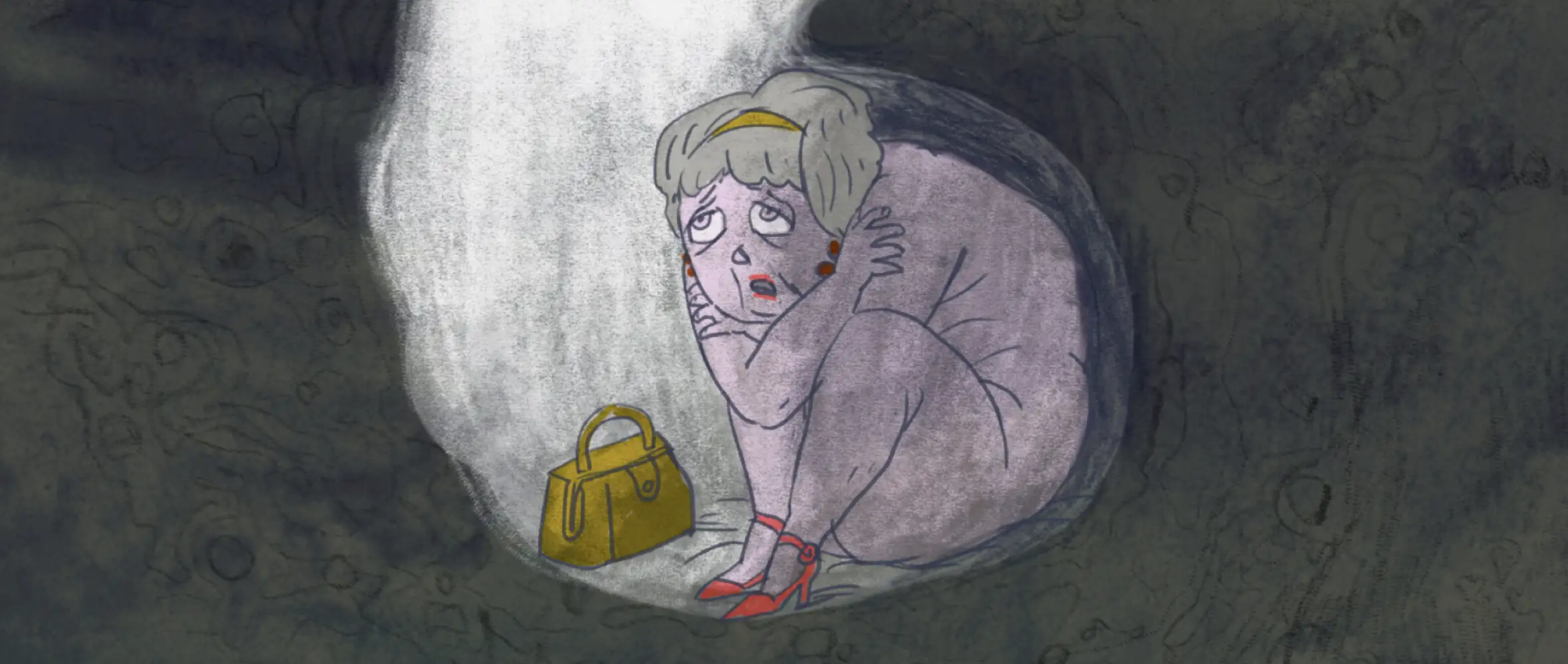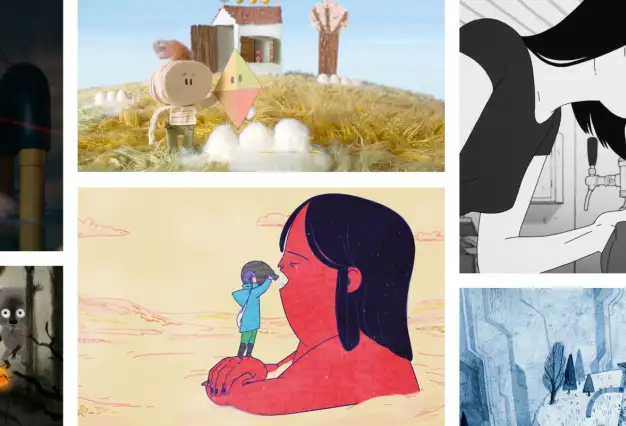
12 May 2025
Animation, absurdism and the female body in transformation
Animation, absurdism and the female body in transformation

After the international success of My Sunny Maad, Czech animator Michaela Pavlátová reunites with long-time producers Petr Oukropec and Kateřina Černá from the production company Negativ on Night Tram, a visually inventive feature that revisits and expands on the surreal world of her Annecy-winning short Tram. Once again working in hand-drawn 2D animation, Pavlátová turns her attention to themes of aging and generational shift through the story of a veteran tram driver undergoing a Kafkaesque transformation. With its layered narrative, stylised absurdism, and ironic female gaze, Night Tram signals a return to the director’s more personal, auteur-driven approach.
by Martin Kudláč for CZECH FILM / Summer 2025
Decorated Czech animator and director Michaela Pavlátová has emerged as a distinctive voice in contemporary European animation, known for her sharp wit, expressive visual style, and nuanced portrayals of women’s inner lives. Her work often blends emotional and societal themes with a characteristic mix of humour, absurdity, and understated poeticism.
Over the past three decades, Pavlátová has worked across a range of formats, including short films, experimental projects, and feature-length works, both animated and live-action. Her films have received recognition from festivals and institutions such as Annecy, Berlin, and the Academy of Motion Picture Arts and Sciences.
A long-standing creative partnership with Prague-based production company Negativ began with a series of shorts and culminated in My Sunny Maad (2021), a 2D animated feature that brought wider international attention. The film, which follows a Czech woman navigating everyday life in Kabul, premiered at Annecy, where it won the Jury Prize. My Sunny Maad later won a César Award and was nominated for a Golden Globe Award, marking a significant milestone for Czech animation internationally. Following My Sunny Maad, Pavlátová reunites with Negativ on her second animated feature, Night Tram, a project that marks a return to her auteur-driven work.
Kafkaesque transformation of an aging body
Pavlátová and production company Negativ first collaborated on Tram (2012), an Annecy-winning short that stood out for its surreal sensuality and sharp visual humour. With Night Tram, they return to its central character, this time through a script written by Pavlátová and based on her own short texts, and personal reflections.
“Thematically, we wanted to dig deeper into the kind of emotional and visual storytelling Michaela does so well in her short films, something intimate, ironic, and distinctly female,” says Oukropec. “As we revisited her earlier work, we realised the protagonist of Tram could evolve into the central figure of a feature-length narrative.”
That protagonist is Božena, a seasoned tram driver in her sixties and the most experienced in the city. But when she has to drive a modern tram, she loses her nerve and is fired. What follows is not a dramatic fall, but a struggle for a new chance in her life, accompanied by a gradual physical transformation.
Her physical body begins to deteriorate, her limbs weaken, her posture collapses, her skin takes on a hardened texture. Eventually, she begins to resemble an insect, a metamorphosis reminiscent of Kafka’s famous short story. While strange, the transformation underscores Božena’s fading visibility in a society that equates relevance with technological fluency and youth.
Parallel to Božena’s descent is her granddaughter Helena’s coming-of-age. At ten years old, Helena is growing taller and is becoming more self-aware, just as Božena is shrinking. This shift alters their relationship, gradually moving from latent tension to a quiet understanding. Božena’s fear of obsolescence intersects with Helena’s search for meaning, anchoring the film in a dialogue between generations. “Božena is a portrait of resilience,” Oukropec notes. “She insists on being useful, even as her body begins to fail her. There’s humour in her journey, but also a kind of urgency that builds as the story progresses.”
Through the evolving bond between grandmother and granddaughter, Night Tram considers how emotional connection can overcome physical decline. The story becomes a meditation on the continuity of life, and on how value is determined by human connection rather than productivity. “The film also has a social level,” Oukropec adds. “We explore how aging is controlled by modern systems, how utility is reduced to economic output, and how this logic marginalises those who fall outside its parameters.”
Beneath the narrative, there is also a personal dimension. While Božena is not a direct self-portrait, the emotional terrain she navigates is closely tied to Pavlátová’s own reflections. “It’s about recognising change in your own body,” Oukropec notes, “and finding a way to laugh at it while maintaining a sense of dignity.”
Hand-drawn surrealism
In contrast to the restrained realism of My Sunny Maad, Night Tram will embrace visual metaphor, stylisation, and absurdist humour. Oukropec describes the film as “a drama laced with dark humour and surreal exaggeration,” drawing partial inspiration from Kafka’s Metamorphosis, though reinterpreted through a different lens. Central to this approach is a strong visual motif of physical transformation: Božena’s aging body morphs on screen in ways that reflect both her internal state and her shifting place in the world. Although the film is character-driven at its core, it deliberately leans towards an original narrative language that is shaped by Pavlátová's ironic and distinctly feminine point of view.
Structurally, the narrative unfolds across several interwoven storylines, each rendered in a unique visual language. These layers are distinguished by changes in colour palette, texture, spatial design, and animation technique. Certain sequences remain grounded in a recognisable reality, conveyed through subdued and realistic animation. Others shift into the surreal, reflecting Božena’s internal experience, her fears, her limitations, and her fantasies through heightened visual exaggeration, stylised compositions, and comic distortions.
The animation is primarily hand-drawn in 2D, created using TVPaint and Toon Boom Harmony, with customised production workflows developed in collaboration with Prague-based Alkay Animation Studio. The team also incorporates unconventional compositing techniques and in-camera effects. These include hand-painted textures, layered elements with varying transparency, and manipulations of time and motion to emphasise emotional moments, stretching or contracting movement for psychological impact.
True to Pavlátová’s auteur style, the production retains a hands-on, artisanal sensibility. She remains closely involved in the creative process, designing key sequences and visual motifs while personally animating select scenes. “Compared to My Sunny Maad, Night Tram is wilder,” Oukropec says. “It’s dynamic, surprising, but always emotionally grounded.”
Poetics over politics
Building on the international momentum of My Sunny Maad, Night Tram continues in the spirit of international collaboration. Negativ once again partners with France’s Sacrebleu Productions, a company known for supporting auteur-driven animated features, most recently recognised with both the 2024 Academy Award and the European Film Award for Flow.
The Franco-Czech co-production model proved effective on My Sunny Maad, not only in terms of financing but in fostering a genuinely transnational production process. A similar structure is being implemented for Night Tram, with Slovak company BFILM returning as a third partner. This tri-national model not only diversifies funding sources, but it also strengthens the creative ecosystem that supported Pavlátová’s previous animated feature.
The project is currently in late development. Czech financing is in place, and French partners are entering the funding phase. Initial visual development has begun, and the production pipeline is being established. The main production window is scheduled between autumn 2025 and spring 2027, with delivery anticipated in late 2027.
The production is assembling an international team that brings together both emerging and established talents. Among them is Andrea Szelesová, an alumna of Pavlátová’s animation atelier at FAMU, whose previous credits include My Sunny Maad alongside her own independent work. The team also includes experienced professionals from past collaborations. While additional minority co-producers may join the project, Oukropec notes that the goal is not solely financial. “We’re looking to enrich the project generationally and culturally. The diversity of the team informs the creative process in essential ways.”
Beneath its surreal visual style, Night Tram addresses themes that resonate with contemporary social realities: the invisibility of older women in the workplace, the isolation experienced by the elderly, and the emotional disconnection that can result from fragmented family structures.
“There’s a societal undercurrent to the film,” Oukropec explains. “It’s a reflection on how our systems define value, how productivity becomes the metric for relevance, and what that logic means for those who fall outside of it. Michaela’s approach is to translate this into something intimate and emotional rather than overtly political.”




